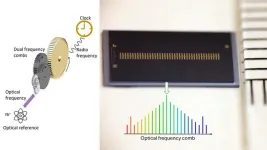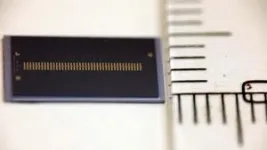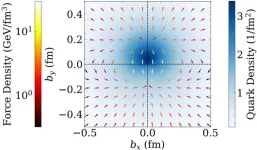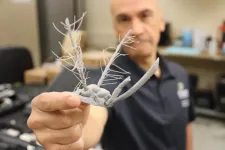(Press-News.org) Optical atomic clocks can increase the precision of time and geographic position a thousandfold in our mobile phones, computers, and GPS systems. However, they are currently too large and complex to be widely used in society. Now, a research team from Purdue University, USA, and Chalmers University of Technology, Sweden, has developed a technology that, with the help of on-chip microcombs, could make ultra-precise optical atomic clock systems significantly smaller and more accessible – with significant benefits for navigation, autonomous vehicles, and geo-data monitoring.
Today, our mobile phones, computers, and GPS systems can give us very accurate time indications and positioning thanks to the over 400 atomic clocks worldwide. All sorts of clocks - be it mechanical, atomic or a smartwatch - are made of two parts: an oscillator and a counter. The oscillator provides a periodic variation of some known frequency over time while the counter counts the number of cycles of the oscillator. Atomic clocks count the oscillations of vibrating atoms that switch between two energy states with very precise frequency.
Most atomic clocks use microwave frequencies to induce these energy oscillations in atoms. In recent years, researchers in the field have explored the possibility of using laser instead to induce oscillations optically. Just like a ruler with a great number of ticks per centimeter, optical atomic clocks make it possible to divide a second into even more time fractions, resulting in thousands of times more accurate time and position indications.
"Today's atomic clocks enable GPS systems with a positional accuracy of a few meters. With an optical atomic clock, you may achieve a precision of just a few centimeters. This improves the autonomy of vehicles, and all electronic systems based on positioning. An optical atomic clock can also detect minimal changes in latitude on the Earth's surface and can be used for monitoring, for example, volcanic activity," says Prof. Minghao Qi from Purdue University, co-author of a study recently published in Nature Photonics.
However, the optical atomic clocks that exist today are bulky and require complex laboratories with specific laser settings and optical components, making it difficult to use them outside lab environments, such as in satellites, remote research stations, or drones. Now, a research team at Purdue University, and Chalmers, has developed a technology that makes optical atomic clocks significantly smaller and accessible for more widespread use in society.
System miniaturised by microcombs
The core of the new technology, described in a recently published research article in Nature Photonics, are small, chip-based devices called microcombs. Like the teeth of a comb, microcombs can generate a spectrum of evenly distributed light frequencies.
“This allows one of the comb frequencies to be locked to a laser frequency that is in turn locked to the atomic clock oscillation,” says Minghao Qi.
While the optical atomic clocks offer much higher precision, the oscillation frequency is at hundreds of THz range – a frequency too high for any electronic circuits to “count” directly. But the researchers’ microcomb chips were able to solve the problem - while enabling the atomic clock system to shrink considerably.
“Fortunately, our microcomb chips can act as a bridge between the optical signals of the atomic clock and the radio frequencies used to count the atomic clock’s oscillations. Moreover, the minimal size of the microcomb makes it possible to shrink the atomic clock system significantly while maintaining its extraordinary precision,” says Victor Torres Company, Professor of Photonics at Chalmers and co-author of the study.
Solving the challenge of self-reference
Another major obstacle has been achieving simultaneously the "self-reference" needed for the stability of the overall system and aligning the microcomb's frequencies exactly with the atomic clock's signals.
“It turns out that one microcomb is not sufficient, and we managed to solve the problem by pairing two microcombs, whose comb spacings, i.e. frequency interval between adjacent teeth, are close but with a small offset, e.g. 20 GHz. This 20 GHz offset frequency will serve as the clock signal that is electronically detectable. In this way, we could get the system to transfer the exact time signal from an atomic clock to a more accessible radio frequency, " says Kaiyi Wu, the leading author of the study at Purdue University.
Chip-based laser optics paving way for accessible atomic optical clocks
The new system also includes integrated photonics, which uses chip-based components rather than bulky laser optics.
“Photonic integration technology makes it possible to integrate the optical components of optical atomic clocks, such as frequency combs, atomic sources and lasers, on tiny photonic chips in micrometer to millimeter sizes, significantly reducing the size and weight of the system,” says Dr. Kaiyi Wu.
The innovation could pave the way for mass production, making optical atomic clocks more affordable and accessible for a range of applications in society and science. The system that is required to “count” the cycles of an optical frequency requires many components besides the microcombs, such as modulators, detectors and optical amplifiers. This study solves an important problem and shows a new architecture, but the next steps are to bring all the elements necessary to create a full system on a chip.
"We hope that future advances in materials and manufacturing techniques can further streamline the technology, bringing us closer to a world where ultra-precise timekeeping is a standard feature in our mobile phones and computers," says Victor Torres Company.
More about the study:
The study “Vernier microcombs for integrated optical atomic clocks” was published in Nature Photonics. The authors are Kaiyi Wu, Nathan P. O’Malley, Saleha Fatema, Cong Wang, Marcello Girardi, Mohammed S. Alshaykh, Zhichao Ye, Daniel E. Leaird, Minghao Qi, Victor Torres-Company and Andrew M. Weiner. At the time of the study, the researchers were active at Purdue University, USA; Chalmers University of Technology, Sweden and King Saud University, Saudi Arabia.
For more information, please contact:
Kaiyi Wu, Postdoctoral Researcher at Purdue University, wu1871@purdue.edu
Victor Torres Company, Professor of Photonics, Microtechnology and Nanoscience at Chalmers University of Technology, Sweden, torresv@chalmers.se +46 31 772 19 04
Minghao Qi, Professor of Electrical and Computer Engineering at Purdue University, USA, mqi@purdue.edu, +1 765 494 3646
The contact persons speak English. They are available for live and pre-recorded interviews. At Chalmers, we have podcast studios and broadcast filming equipment on site and would be able to assist a request for a television, radio or podcast interview.
Banner image caption: The microcomb chips developed by the research team at Purdue University and Chalmers can help shrink down optical atomic clock systems considerably and make them more accessible in society. As a result, optical atomic clocks may be used in satellites and remote research stations, enabling a thousand times more precise GPS systems, with great benefits for autonomous vehicles and all electric systems based on positioning. Like the teeth of a comb, a microcomb consists of a spectrum of evenly distributed light frequencies. Optical atomic clocks can be built by locking a microcomb tooth to a ultranarrow-linewidth laser, which in turn locks to an atomic transition with extremely high frequency stability. That way, frequency combs act like a bridge between the atomic transition at an optical frequency and the clock signal at a radio frequency that is electronically detectable for counting the oscillations – enabling extraordinary precision. The researchers’ photonic chip, on the righthand side of the image, contains 40 microcombs generators and is only five millimeters wide.
Banner image credit: Chalmers University of Technology\ Kaiyi Wu
Additional images related to this press release can be downloaded via this link.
END
Microcomb chips help pave the way for thousand times more accurate GPS systems
2025-02-21
ELSE PRESS RELEASES FROM THIS DATE:
Illuminating the proton’s inner workings
2025-02-21
Scientists have now mapped the forces acting inside a proton, showing in unprecedented detail how quarks—the tiny particles within—respond when hit by high-energy photons.
The international team includes experts from the University of Adelaide who are exploring the structure of sub-atomic matter to try and provide further insight into the forces that underpin the natural world.
“We have used a powerful computational technique called lattice quantum chromodynamics to map the forces acting inside ...
Genetic therapy gives infants life-changing improvements in sight
2025-02-21
Four young children have gained life-changing improvements in sight following treatment with a pioneering new genetic medicine through UCL Institute of Ophthalmology and Moorfields Eye Hospital, with the support of MeiraGTx.
The children were born with a severe impairment to their sight due to a rare genetic deficiency that affects the AIPL1 gene. The condition, a form of retinal dystrophy, means those affected are born with only sufficient sight to distinguish between light and darkness. The gene defect causes ...
Impacts of workplace bullying on sleep can be “contagious” between partners
2025-02-21
Workplace bullying affects not only the employee’s sleep but their partner’s too, according to new research published today.
Exposure to bullying by superiors and/or colleagues has been linked to a variety of negative health outcomes, such as sleep problems.
Now research by the University of East Anglia (UEA) in the UK, and Complutense University of Madrid and Seville University in Spain, sheds light on the short-term consequences of workplace bullying on various indicators of sleep.
These include waking up too early (sleep severity), interference with daily life (sleep impact) and dissatisfaction with own sleep (sleep satisfaction).
Writing in ...
UK peatland fires are supercharging carbon emissions as climate change causes hotter, drier summers
2025-02-21
A new study led by the University of Cambridge has revealed that as our springs and summers get hotter and drier, the UK wildfire season is being stretched and intensified. More fires, taking hold over more months of the year, are causing more carbon to be released into the atmosphere as carbon dioxide.
Fires on peatlands, which are carbon-rich, can almost double global fire-driven carbon emissions. Researchers found that despite accounting for only a quarter of the total UK land area that burns each year, dwarfed by moor and heathland, peatland fires have caused up to 90% of annual UK fire-driven carbon emissions since 2001 – with emissions ...
Coastal erosion threatens this ancient city — and others much closer to home
2025-02-20
A new USC study reveals a dramatic surge in building collapses in the ancient Egyptian port city of Alexandria, directly linked to rising sea levels and seawater intrusion.
Once a rare occurrence, building collapses in Alexandria — one of the world’s oldest cities, often called the “bride of the Mediterranean” for its beauty — have accelerated from approximately one per year to an alarming 40 per year over the past decade, the researchers found.
“The true cost of this loss extends far beyond bricks and mortar. We are witnessing the gradual disappearance of historic coastal ...
Walgreens supports the American Heart Association to bring CPR to communities nationwide
2025-02-20
DALLAS, Feb. 20, 2025 — The American Heart Association, a global force devoted to changing the future of health for all, and Walgreens, one of the nation's largest community-based pharmacies, are stepping up to support the Association’s Nation of Lifesavers™ movement nationwide. Walgreens will lead efforts in its stores and communities to raise awareness of CPR and drive CPR training and consumer support of the Association’s ...
How mosquitos hear may inspire new ways to detect natural disasters
2025-02-20
One of nature’s most disliked creatures may very well unlock a breakthrough in disaster response.
A multidisciplinary Purdue University research team is recreating mosquito antennae to better study their sensitivity to vibrations. Should the research prove fruitful, it could lead to improvements in monitoring and detecting natural disasters such as earthquakes and tsunamis.
Research groups under Purdue professors Pablo Zavattieri and Ximena Bernal conducted this work, which is published in the journal Acta Biomaterialia.
“We’re still in the early stages but we’re ...
Child ADHD risk linked to mother’s use of acetaminophen
2025-02-20
Fetal acetaminophen exposure increases the likelihood that a child will develop attention-deficit/hyperactivity disorder (ADHD), according to a study published Feb. 6 in Nature Mental Health.
Prior research shows that upward of 70% of pregnant women use acetaminophen during pregnancy to control pain or reduce fever. The drug, which is the active ingredient of many pain-relief medications, is one of the few considered safe to take during pregnancy by the U.S. Food and Drug ...
New solution to help therapy ‘dropouts’
2025-02-20
‘The most common number of therapy sessions people access is one’
Common in other countries but not in the U.S., single-session interventions are designed to treat patients in just one meeting
Lab at Northwestern offers digital single-session interventions for youth in nine languages
CHICAGO --- Seeking mental health help is a significant step, but that first intake session can often feel more like paperwork than progress, and a significant proportion of people “drop out” or never return for a second visit, previous research has shown.
“The most common number of sessions ...
New AI system accurately maps urban green spaces, exposing environmental divides
2025-02-20
A research team led by Rumi Chunara - an NYU associate professor with appointments in both the Tandon School of Engineering and the School of Global Public Health – has unveiled a new artificial intelligence (AI) system that uses satellite imagery to track urban green spaces more accurately than prior methods, critical to ensuring healthy cities.
To validate their approach, the researchers tested the system in Karachi, Pakistan's largest city where several team members are based. Karachi proved an ideal test case with its mix of dense urban areas and varying vegetation conditions.
Accepted for publication by the ACM Journal on Computing and Sustainable Societies, ...






